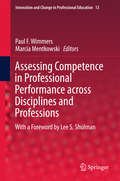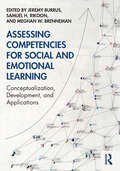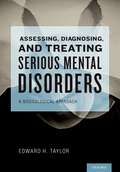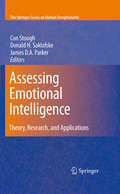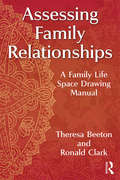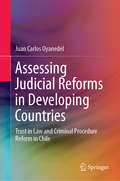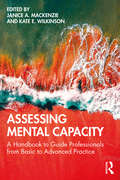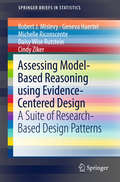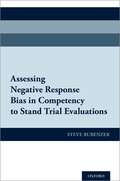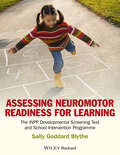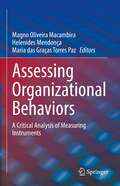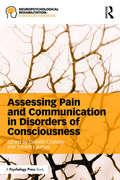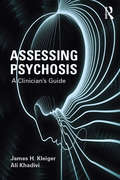- Table View
- List View
Assessing Competence in Professional Performance across Disciplines and Professions (Innovation and Change in Professional Education #13)
by Paul F. Wimmers Marcia MentkowskiThis book examines the challenges of cross-professional comparisons and proposes new forms of performance assessment to be used in professions education. It addresses how complex issues are learned and assessed across and within different disciplines and professions in order to move the process of “performance assessment for learning” to the next level. In order to be better equipped to cope with increasing complexity, change and diversity in professional education and performance assessment, administrators and educators will engage in crucial systems thinking. The main question discussed by the book is how the required competence in the performance of students can be assessed during their professional education at both undergraduate and graduate levels. To answer this question, the book identifies unresolved issues and clarifies conceptual elements for performance assessment. It reviews the development of constructs that cross disciplines and professions such as critical thinking, clinical reasoning, and problem solving. It discusses what it means to instruct and assess students within their own domain of study and across various roles in multiple contexts, but also what it means to instruct and assess students across domains of study in order to judge integration and transfer of learning outcomes. Finally, the book examines what it takes for administrators and educators to develop competence in assessment, such as reliably judging student work in relation to criteria from multiple sources. "... the co-editors of this volume, Marcia Mentkowski and Paul F. Wimmers, are associated with two institutions whose characters are so intimately associated with the insight that assessment must be integrated with curriculum and instructional program if it is to become a powerful influence on the educational process ..." Lee Shulman, Stanford University
Assessing Competencies for Social and Emotional Learning: Conceptualization, Development, and Applications
by Jeremy Burrus Samuel H. Rikoon Meghan W. BrennemanAssessing Competencies for Social and Emotional Learning explores the conceptualization, development, and application of assessments of competencies and contextual factors related to social and emotional learning (SEL). As programs designed to teach students social and emotional competencies are being adopted at an ever‐increasing rate, new measurements are needed to understand their impact on student attitudes, behaviors, and academic performance. This book integrates standards of fairness, reliability, and validity, and lessons learned from personality and attitude assessment to facilitate the principled development and use of SEL assessments. Education professionals, assessment developers, and researchers will be better prepared to systematically develop and evaluate measures of social and emotional competencies.
Assessing Competencies for Social and Emotional Learning: Conceptualization, Development, and Applications
by Jeremy Burrus Samuel H. Rikoon Meghan W. BrennemanAssessing Competencies for Social and Emotional Learning explores the conceptualization, development, and application of assessments of competencies and contextual factors related to social and emotional learning (SEL). As programs designed to teach students social and emotional competencies are being adopted at an ever‐increasing rate, new measurements are needed to understand their impact on student attitudes, behaviors, and academic performance. This book integrates standards of fairness, reliability, and validity, and lessons learned from personality and attitude assessment to facilitate the principled development and use of SEL assessments. Education professionals, assessment developers, and researchers will be better prepared to systematically develop and evaluate measures of social and emotional competencies.
Assessing, Diagnosing, And Treating Serious Mental Disorders: A Bioecological Approach
by Edward H. TaylorAssessing Emotional Intelligence: Theory, Research, and Applications (The Springer Series on Human Exceptionality)
by Donald H. Saklofske Con Stough James D.A. ParkerManaging human emotions plays a critical role in everyday functioning. After years of lively debate on the significance and validity of its construct, emotional intelligence (EI) has generated a robust body of theories, research studies, and measures. Assessing Emotional Intelligence: Theory, Research, and Applications strengthens this theoretical and evidence base by addressing the most recent advances and emerging possibilities in EI assessment, research, and applications. This volume demonstrates the study and application of EI across disciplines, ranging from psychometrics and neurobiology to education and industry. Assessing Emotional Intelligence carefully critiques the key measurement issues in EI, and leading experts present EI as eminently practical and thoroughly contemporary as they offer the latest findings on: EI instruments, including the EQ-I, MSCEIT, TEIQue, Genos Emotional Intelligence Inventory, and the Assessing Emotions Scale. The role of EI across clinical disorders. Training professionals and staff to apply EI in the workplace. Relationships between EI and educational outcomes. Uses of EI in sports psychology. The cross-cultural relevance of EI. As the contributors to this volume in the Springer Series on Human Exceptionality make clear, these insights and methods hold rich potential for professionals in such fields as social and personality psychology, industrial and organizational psychology, psychiatry, business, and education.
Assessing Family Relationships: A Family Life Space Drawing Manual
by Theresa A. Beeton Ronald A. ClarkAssessing Family Relationships shows mental health professionals how to utilize the Family Life Space Drawing (the FLSD), a family assessment tool that incorporates information from multiple family members while building connections between the clinician and the client. In this manual, Theresa A. Beeton and Ronald A. Clark demonstrate the usefulness of the FLSD in both family and couple counseling. As a task-centered assessment tool, the FLSD enables an interactive and personalized process of counseling, which helps individuals to express concerns and information about themselves in an indirect and nonthreatening manner. Chapters are illustrated throughout with case studies and drawings adapted from the authors’ own clinical experience, and the manual offers an overview of the history of the FLSD, as well as where future research is headed. Providing a practical explanation of how to complete the FLSD process, Assessing Family Relationships will be highly relevant to couple and family therapists, as well as clinical social workers, who are interested in updating their practice with innovative family assessment research and techniques.
Assessing Family Relationships: A Family Life Space Drawing Manual
by Theresa A. Beeton Ronald A. ClarkAssessing Family Relationships shows mental health professionals how to utilize the Family Life Space Drawing (the FLSD), a family assessment tool that incorporates information from multiple family members while building connections between the clinician and the client. In this manual, Theresa A. Beeton and Ronald A. Clark demonstrate the usefulness of the FLSD in both family and couple counseling. As a task-centered assessment tool, the FLSD enables an interactive and personalized process of counseling, which helps individuals to express concerns and information about themselves in an indirect and nonthreatening manner. Chapters are illustrated throughout with case studies and drawings adapted from the authors’ own clinical experience, and the manual offers an overview of the history of the FLSD, as well as where future research is headed. Providing a practical explanation of how to complete the FLSD process, Assessing Family Relationships will be highly relevant to couple and family therapists, as well as clinical social workers, who are interested in updating their practice with innovative family assessment research and techniques.
Assessing Foreign Language Students’ Spoken Proficiency: Stakeholder Perspectives on Assessment Innovation (Educational Linguistics #26)
by Martin EastThis book presents an in‐depth study of assessment innovation and its impact on teaching and learning. The context is New Zealand, and the focus is additional languages other than English and the recent introduction of a radical new assessment of students’ spoken proficiency, called interact. The book crosses the traditional theoretical and methodological boundaries associated with language testing research, which focuses on assessment performance, and presents an alternative approach where stakeholders become the centre of interest. It advances our understanding of how assessment innovation impacts on two key groups - teachers and students in schools - based on data collected from a substantial two‐year research project. It presents an account of these stakeholders’ perceptions of the validity and usefulness of the new assessment in comparison with the more traditional test that it has replaced.Assessing Foreign Language Students' Spoken Proficiency makes an outstanding and original contribution to the field of second and foreign language teaching, providing a theory and research-based account of the development of a learner-centred approach to oral proficiency assessment. It is an important resource for teachers and teacher educators as well as assessment and curriculum specialists worldwide. It deserves to be widely read.
Assessing Impairment: From Theory to Practice
by Sam Goldstein Jack NaglieriImpairment and disability are widely used terms, yet considerable disagreement exists as to their relationship—especially when impairment means different things to different professionals in the fields of mental health, medicine, and education. Although diagnostic criteria for various disorders are clearly detailed in the DSM-IV and elsewhere, criteria for impairment remain elusive. And patients with severe limitations but minimal symptoms, or the reverse, further complicate the discussion. The first in-depth treatment of the theory, definition, and evaluation of this core concept, Assessing Impairment: From Theory to Practice cuts through the confusion and cross-talk. Leading scholars and clinicians offer a robust evidence base for a much-needed reconceptualization of impairment within the context of diagnosis and disability, arguing for a wide-ranging quality-of-life perspective. This contextual approach to assessment goes beyond mere symptom counting, resulting in more accurate diagnosis, targeted interventions, and improved patient functioning. Within this concise but comprehensive volume, coverage focuses on key areas including: Current conceptualizations from the DSM-IV and other medical models. Methodologies for measuring symptom severity and impairment. Social/behavioral issues, such as resilience, adaptive behaviors, and family environment. Developmental issues across the life span. Legal and ethical questions and civil rights issues. Impairment and disability as they relate to trauma. The interdisciplinary model proposed in Assessing Impairment gives clinicians vital tools for working with the unique limitations and strengths of every patient. Child, school, and educational psychologists will find it particularly useful, given the critical importance of early detection and the complexity of young people’s lives.
Assessing Impairment: From Theory to Practice
by Sam Goldstein Jack A. NaglieriThis Second Edition of the book expands on the in-depth treatment of the theory, definition, and evaluation of impairment presented in the original volume. It explores the complex relationships between disabling conditions and impairment, with new data and insights on assessment and potential avenues for treatment. Original and revised chapters critique current models of impairment and offers an integrated model rooted in the contexts of medical, mental health, and cognitive challenges in disability. Leading scholars and clinicians provide updated evidence for a much-needed reconceptualization of impairment within the context of diagnosis and disability. This contextual approach to assessment – a wide-ranging quality-of life perspective – goes beyond symptom counting, resulting in more accurate diagnosis, targeted interventions, and improved patient functioning.Topics featured in this book include:The role of family and cross-setting supports in reducing impairment.Relationships between adaptive behavior and impairment.Legal conceptions of impairment and its implications for the assessment of psychiatric disabilities.Impairment in parenting.The Neuropsychological Impairment Scale (NIS).The Barkley Functional Impairment Scale (BFIS).The Rating Scale of Impairment (RSI).Treatment integrity in interventions for children diagnosed with DSM-5 disorders.Assessing Impairment, Second Edition, is a must-have resource for researchers, clinicians, professionals, and graduate students in clinical child, school, and developmental psychology as well as child and adolescent psychiatry, educational psychology, rehabilitation medicine/therapy, social work, and pediatrics.
Assessing Judicial Reforms in Developing Countries: Trust in Law and Criminal Procedure Reform in Chile
by Juan Carlos OyanedelThis book examines how judicial reform can be effectively assessed through a procedural justice approach. It provides a practical framework for assessment of judicial reform, examining a successful reform in Chile through large scale surveys and longitudinal research.Judicial reform is a key element to democratization and modernization processes in the developing world. Practitioners have struggled with ways to analyze the effects of judicial reform, and to define success. Procedural justice theorists propose that people will obey the law if they consider it fair; this affects willingness to collaborate with the police and the courts, and the general approach that the public has towards social regulations. Judicial reforms such as criminal procedure reforms, which explicitly guarantee the development of a fairer judicial process, represent a scenario that puts these theoretical assumptions to the test. With policy recommendations and applications for international judicial reform, this book tests the real conditions of a procedural justice approach with empirical assessment and analysis. With implications for Latin America and countries undergoing judicial or political reforms worldwide, this book will be an important resource for researchers, policy makers and all those interested in the analysis of judicial reforms, democratization processes and the psychology of justice.
Assessing Literacy in Deaf Individuals: Neurocognitive Measurement and Predictors
by Donna A. Morere and Thomas AllenHumans’ development of literacy has been a recent focus of intense research from the reading, cognitive, and neuroscience fields. But for individuals who are deaf—who rely greatly on their visual skills for language and learning—the findings don’t necessarily apply, leaving theoretical and practical gaps in approaches to their education. Assessing Literacy in Deaf Individuals: Neurocognitive Measurement and Predictors narrows these gaps by introducing the VL2 Toolkit, a comprehensive test battery for assessing the academic skills and cognitive functioning of deaf persons who use sign language. Skills measured include executive functioning, memory, reading, visuospatial ability, writing fluency, math, and expressive and receptive language. Comprehensive data are provided for each, with discussion of validity and reliability issues as well as ethical and legal questions involved in the study. And background chapters explain how the Toolkit was compiled, describing the procedures of the study, its rationale, and salient characteristics of its participants. This notable book:Describes each Toolkit instrument and the psychometric properties it measures. Presents detailed findings on test measures and relationships between skills.Discusses issues and challenges relating to visual representations of English, including fingerspelling and lipreading.Features a factor analysis of the Toolkit measures to identify underlying cognitive structures in deaf learners.Reviews trends in American Sign Language assessment.Assessing Literacy in Deaf Individuals is an essential reference for researchers, graduate students, clinicians, and other professionals working in the field of deafness and deaf education across in such areas as clinical child and school psychology, audiology, and linguistics.
Assessing Mental Capacity: A Handbook to Guide Professionals from Basic to Advanced Practice
by Janice A. Mackenzie Kate E. WilkinsonThis practical, how-to handbook provides essential resources to help clinicians and other professionals assess mental capacity in key decisions. The book illustrates the basics of capacity assessments before discussing a variety of complex issues of which professionals will need to be aware. Offering expertise from a multi-disciplinary perspective, the book provides hands-on coverage of mental capacity law (concentrating on England and Wales). This book is accompanied by online resources including semi-structured interviews and a multi-disciplinary team (MDT) questionnaire which can be downloaded and used for clinical cases, as well as further examples, information and tips. Please visit www.assessingcapacity.com. Chapters are written by a variety of different professionals with extensive experience in the assessment of mental capacity. Coverage includes: Explanations of mental capacity law and how to put it into practice across a range of settings, services and populations A "how to" approach for administering assessments of mental capacity both for professionals who are new to the area and for more experienced professionals Information on practical aspects of assessing mental capacity for commonly occurring decisions and for more specialist and complex decisions Consideration of the best interests process and Liberty Protection Safeguards (LPS). With easily accessible information, case studies, examples from case law and internationally relevant discussions on ethical issues, this is the perfect companion to help busy professionals understand complex concepts relating to mental capacity.
Assessing Mental Capacity: A Handbook to Guide Professionals from Basic to Advanced Practice
by Janice A. Mackenzie Kate E. WilkinsonThis practical, how-to handbook provides essential resources to help clinicians and other professionals assess mental capacity in key decisions. The book illustrates the basics of capacity assessments before discussing a variety of complex issues of which professionals will need to be aware. Offering expertise from a multi-disciplinary perspective, the book provides hands-on coverage of mental capacity law (concentrating on England and Wales). This book is accompanied by online resources including semi-structured interviews and a multi-disciplinary team (MDT) questionnaire which can be downloaded and used for clinical cases, as well as further examples, information and tips. Please visit www.assessingcapacity.com. Chapters are written by a variety of different professionals with extensive experience in the assessment of mental capacity. Coverage includes: Explanations of mental capacity law and how to put it into practice across a range of settings, services and populations A "how to" approach for administering assessments of mental capacity both for professionals who are new to the area and for more experienced professionals Information on practical aspects of assessing mental capacity for commonly occurring decisions and for more specialist and complex decisions Consideration of the best interests process and Liberty Protection Safeguards (LPS). With easily accessible information, case studies, examples from case law and internationally relevant discussions on ethical issues, this is the perfect companion to help busy professionals understand complex concepts relating to mental capacity.
Assessing Model-Based Reasoning using Evidence- Centered Design: A Suite of Research-Based Design Patterns (SpringerBriefs in Statistics)
by Robert J Mislevy Geneva Haertel Michelle Riconscente Daisy Wise Rutstein Cindy ZikerThis Springer Brief provides theory, practical guidance, and support tools to help designers create complex, valid assessment tasks for hard-to-measure, yet crucial, science education standards. Understanding, exploring, and interacting with the world through models characterizes science in all its branches and at all levels of education. Model-based reasoning is central to science education and thus science assessment. Current interest in developing and using models has increased with the release of the Next Generation Science Standards, which identified this as one of the eight practices of science and engineering. However, the interactive, complex, and often technology-based tasks that are needed to assess model-based reasoning in its fullest forms are difficult to develop. Building on research in assessment, science education, and learning science, this Brief describes a suite of design patterns that can help assessment designers, researchers, and teachers create tasks for assessing aspects of model-based reasoning: Model Formation, Model Use, Model Elaboration, Model Articulation, Model Evaluation, Model Revision, and Model-Based Inquiry. Each design pattern lays out considerations concerning targeted knowledge and ways of capturing and evaluating students’ work. These design patterns are available at http://design-drk.padi.sri.com/padi/do/NodeAction?state=listNodes&NODE_TYPE=PARADIGM_TYPE. The ideas are illustrated with examples from existing assessments and the research literature.
Assessing Negative Response Bias in Competency to Stand Trial Evaluations
by Steven J. RubenzerEvaluations of a defendant's competence to stand trial (CST) are probably the most frequently performed forensic evaluations, with estimates in the United States ranging from 60,000 to 70,000 annually. In order for CST evaluations to be considered thorough and accurate, examiners must assess for possible lack of cooperation, feigning, or malingering - the intentional production or gross exaggeration of false or grossly exaggerated physical or psychiatric symptoms, motivated by external incentives. Yet, there are accounts that CST examiners often do not assess for negative response bias, and even if they do nevertheless fail to identify a considerable number of examinees that do feign. Assessing Negative Response Bias in Competency to Stand Trial Evaluations provides readers with a comprehensive guide to assessing whether a defendant has feigned mental impairment during a competency to stand trial evaluation, or simply did not put forth his/her best effort. This book reviews the literature on assessing feigning and negative response bias, with particular focus on issues, tests, and data relevant to CST evaluations, and examines proposed criteria and statistical methods of determining and classifying assessment results. It introduces readers to aspects of the vibrant neuropsychological response style literature, an area many forensic psychologists appear to have overlooked. Additionally, it offers recommendations for research and policy regarding the parameters of CST assessment.
Assessing Negative Response Bias in Competency to Stand Trial Evaluations
by Steven J. RubenzerEvaluations of a defendant's competence to stand trial (CST) are probably the most frequently performed forensic evaluations, with estimates in the United States ranging from 60,000 to 70,000 annually. In order for CST evaluations to be considered thorough and accurate, examiners must assess for possible lack of cooperation, feigning, or malingering - the intentional production or gross exaggeration of false or grossly exaggerated physical or psychiatric symptoms, motivated by external incentives. Yet, there are accounts that CST examiners often do not assess for negative response bias, and even if they do nevertheless fail to identify a considerable number of examinees that do feign. Assessing Negative Response Bias in Competency to Stand Trial Evaluations provides readers with a comprehensive guide to assessing whether a defendant has feigned mental impairment during a competency to stand trial evaluation, or simply did not put forth his/her best effort. This book reviews the literature on assessing feigning and negative response bias, with particular focus on issues, tests, and data relevant to CST evaluations, and examines proposed criteria and statistical methods of determining and classifying assessment results. It introduces readers to aspects of the vibrant neuropsychological response style literature, an area many forensic psychologists appear to have overlooked. Additionally, it offers recommendations for research and policy regarding the parameters of CST assessment.
Assessing Neuromotor Readiness for Learning: The INPP Developmental Screening Test and School Intervention Programme
by Sally Goddard BlytheAssessing Neuromotor Readiness for Learning is a substantially revised and expanded edition of a long established INPP training manual that has been consistently proven in practice. The package includes tests for children, a developmental movement programme, and information about online access to INPP video training materials. Based on the proven INPP model for neuromotor development screening and intervention, which is unique in having been rigorously evaluated in research and practice Expands and revises an INPP manual which has previously only been available to training customers, and which is a foundation stone of the overall INPP approach Places emphasis on children's physical development and how neuro-motor skills provide the foundations for learning success. The package includes batteries of tests for younger and older children, a developmental movement programme This book may be supported and enhanced by INPP video training materials and score sheets, available for download purchase from the INPP website
Assessing Neuromotor Readiness for Learning: The INPP Developmental Screening Test and School Intervention Programme
by Sally Goddard BlytheAssessing Neuromotor Readiness for Learning is a substantially revised and expanded edition of a long established INPP training manual that has been consistently proven in practice. The package includes tests for children, a developmental movement programme, and information about online access to INPP video training materials. Based on the proven INPP model for neuromotor development screening and intervention, which is unique in having been rigorously evaluated in research and practice Expands and revises an INPP manual which has previously only been available to training customers, and which is a foundation stone of the overall INPP approach Places emphasis on children's physical development and how neuro-motor skills provide the foundations for learning success. The package includes batteries of tests for younger and older children, a developmental movement programme This book may be supported and enhanced by INPP video training materials and score sheets, available for download purchase from the INPP website
Assessing Organizational Behaviors: A Critical Analysis of Measuring Instruments
by Magno Oliveira Macambira Helenides Mendonça Maria das Graças Torres PazThis book fills a gap in international literature by providing critical reviews on variables of organizational behavior and the main psychological instruments developed to measure them. Measuring instruments developed with theoretical and methodological rigor in the field of Organizational and Work Psychology can contribute to the development of diagnostic analyses to enable organizations to implement the evidence-based changes required for their survival. These changes demand diagnoses based on precise assessments of organizational and individual variables, but many times the professionals responsible for conducting these assessments are not sure of what is the best measuring instrument available. This book is intended to serve as a guide to these professionals. The volume is divided in two parts. The first part brings together chapters dedicated to the following micro-organizational variables: Job Crafting, reactions to organizational change, Psychological Wellbeing at Work, Bridge Employment Assessment in the Work-Retirement Transition, Resilience at Work, and Leadership in Organizations. The second part presents the state-of-the-art of research on the following macro-organizational constructs: Quality of Life at Work, Organizational Climate for Creativity, Values and Organizations, Assessments of Organizational Support, and Contributions by Social Networks Analysis and Organizational Effectiveness. The last chapter presents a critical discussion about the nature and future of organization behavior measuring. Assessing Organizational Behaviors: A Critical Analysis of Measuring Instruments is intended to help market professionals select the diagnostic instruments that best fit into their organizational reality in order to correctly assess organizational behavior. The book will also be of interest to researchers and students in the field of Organizational and Work Psychology as it provides comprehensive overviews of a wide range of instruments developed to measure different variables of organizational behavior.
Assessing Pain and Communication in Disorders of Consciousness (Neuropsychological Rehabilitation: A Modular Handbook)
by Steven Laureys Camille ChatelleRecent advances in medicine for resuscitation and care have led to an increased number of patients that survive severe brain damage but who are poorly responsive and non-communicative at the bedside. This has led to a striking need to better characterize, understand, and manage this population who present a real challenge for the assessment of pain and for planning treatment. This edited collection provides clinicians with a guide to recent developments in research on pain perception and assessment, and the detection of consciousness and communication in patients with disorders of consciousness (DOC). With contributions from leading global researchers, the book gives an overview of issues concerning the assessment of pain. It also covers the development of suitable tools both to improve pain management and to detect consciousness and communication in these patients, to influence their prognosis and treatment, and their quality of life. Methodological and ethical issues concerning the implication for future research are also considered. The book will be an invaluable guide for clinicians, medics and therapists working in rehabilitation and acute care, particularly in the demanding field of pain perception, pain assessment and detection of consciousness and communication in patients with DOC. It will also be useful for students and researchers in neuropsychology and medical sciences.
Assessing Pain and Communication in Disorders of Consciousness (Neuropsychological Rehabilitation: A Modular Handbook)
by Steven Laureys Camille ChatelleRecent advances in medicine for resuscitation and care have led to an increased number of patients that survive severe brain damage but who are poorly responsive and non-communicative at the bedside. This has led to a striking need to better characterize, understand, and manage this population who present a real challenge for the assessment of pain and for planning treatment. This edited collection provides clinicians with a guide to recent developments in research on pain perception and assessment, and the detection of consciousness and communication in patients with disorders of consciousness (DOC). With contributions from leading global researchers, the book gives an overview of issues concerning the assessment of pain. It also covers the development of suitable tools both to improve pain management and to detect consciousness and communication in these patients, to influence their prognosis and treatment, and their quality of life. Methodological and ethical issues concerning the implication for future research are also considered. The book will be an invaluable guide for clinicians, medics and therapists working in rehabilitation and acute care, particularly in the demanding field of pain perception, pain assessment and detection of consciousness and communication in patients with DOC. It will also be useful for students and researchers in neuropsychology and medical sciences.
Assessing Psychosis: A Clinician's Guide
by James H. Kleiger Ali KhadiviAssessing Psychosis: A Clinician’s Guide offers both a practical guide and rich clinical resource for a broad audience of mental-health practitioners seeking to sharpen their understanding of diagnostic issues, clinical concepts, and assessment methods that aid in detecting the presence of psychotic phenomena. Practicing psychiatrists, psychologists, social workers, and psychiatric nurses will find this a valuable resource for clinical practice, training, and teaching purposes.
Assessing Psychosis: A Clinician's Guide
by James H. Kleiger Ali KhadiviAssessing Psychosis: A Clinician’s Guide offers both a practical guide and rich clinical resource for a broad audience of mental-health practitioners seeking to sharpen their understanding of diagnostic issues, clinical concepts, and assessment methods that aid in detecting the presence of psychotic phenomena. Practicing psychiatrists, psychologists, social workers, and psychiatric nurses will find this a valuable resource for clinical practice, training, and teaching purposes.
Assessing Psychosis: A Clinician's Guide
by James H. Kleiger Ali KhadiviThis second edition of Assessing Psychosis: A Clinician’s Guide offers both a practical guide and rich clinical resource for a broad audience of mental health practitioners seeking to sharpen their understanding of diagnostic issues, clinical concepts, and assessment methods that aid in detecting the presence of psychotic phenomena. Case vignettes deepen clinical understanding, and all chapters include a summary of practical clinical guidelines. This new edition includes two new chapters and updated diagnostic criteria considering the new DSM-5-TR. Practicing psychiatrists, psychologists, social workers, psychiatric nurses and students will find this a valuable resource for clinical practice, training, and teaching purposes.
